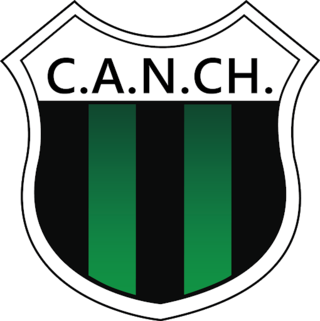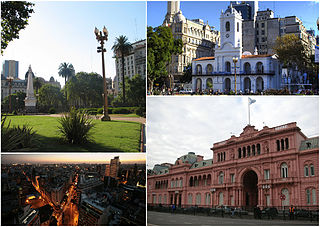
La Recoleta Cemetery is a cemetery located in the Recoleta neighbourhood of Buenos Aires, Argentina. It contains the graves of notable people, including Eva Perón, presidents of Argentina, Nobel Prize winners, the founder of the Argentine Navy, and military commanders such as Julio Argentino Roca. In 2011, the BBC hailed it as one of the world's best cemeteries, and in 2013, CNN listed it among the 10 most beautiful cemeteries in the world.

The La Chacarita Cemetery is a cemetery located in the Chacarita neighborhood in Buenos Aires, Argentina. Occuping a surface of 95 hectare, it is the largest in the country.

Balvanera is a barrio or neighborhood of Buenos Aires, Argentina.

Recoleta is a barrio or neighborhood of Buenos Aires, Argentina, located in the northern part of the city, by the Río de la Plata. The area is perhaps best known to be the home of the distinguished Recoleta Cemetery. It is a traditional upper-class and conservative neighborhood with some of the priciest real estate in the city, known for Paris-style townhouses, lavish former palaces and posh boutiques.

San Vicente is a town and administrative centre of San Vicente Partido, in the province of Buenos Aires, Argentina. The southernmost town in the Greater Buenos Aires metropolitan area, San Vicente is 48 km (30 mi) from downtown Buenos Aires, and can be accessed from Constitución Station by bus via Line 79 or a 20-minute drive by Provincial Route 58 from Ezeiza International Airport. The city has about 21,000 inhabitants per the 2001 census [INDEC].

José Esteban Antonio Echeverría was an Argentine poet, fiction writer, cultural promoter, and liberal activist who played a significant role in the development of Argentine literature, not only through his own writings but also through his organizational efforts. He was one of Latin America's most important Romantic authors. Echeverría's romantic liberalism was influenced by both the democratic nationalism of Giuseppe Mazzini and the utopian socialist doctrines of Henri de Saint-Simon.

Club Atlético Nueva Chicago is an Argentine sports club based in Mataderos, a neighborhood in the west side of Buenos Aires, formerly called "Nueva Chicago". The club's nickname, El Torito is an allusion to legendary 1930s boxer Justo Suárez, known as El Torito de Mataderos.

Estadio Nueva Chicago is a football stadium located in the Mataderos neighborhood of Buenos Aires, Argentina. It is also popularly known as Estadio República de Mataderos. The stadium, inaugurated in 1940, is owned and operated by Club Atlético Nueva Chicago. It has a capacity of 20,000.

Retiro is a barrio or neighborhood in Buenos Aires, Argentina. Located in the northeast end of the city, Retiro is bordered on the south by the Puerto Madero and San Nicolás, and on the west by the Recoleta.

Liniers is a barrio (neighborhood) of Buenos Aires on the edge of the city, centered on Rivadavia Avenue. It is also an important train station and bus hub, connecting western Gran Buenos Aires with the Buenos Aires Metro.

Caballito is a barrio (neighborhood) of the Argentine capital, Buenos Aires. It is the only barrio in the administrative division Comuna 6.

Plaza Miserere is one of the main plazas (squares) of Buenos Aires, Argentina. It is located alongside the Once de Septiembre Station of the Ferrocarril Domingo Faustino Sarmiento in the heart of the Balvanera neighborhood.

Colegiales is a barrio or district in Buenos Aires, Argentina. It is located between Alvarez Thomas av., Forest av., De los Incas av., Virrey del Pino st., Cabildo av., Jorge Newbery st., Crámer st. and Dorrego av. This neighborhood offers a vast amount of contrast and opportunities.

Parque Patricios is a barrio located on the southern side of Buenos Aires, Argentina belonging to the fourth comuna.

According to the World Travel & Tourism Council (WTTC) the travel and tourism sector of Argentina was moving towards recovering its pre-covid pandemic contribution to GDP in mid-2023, led by Buenos Aires.

Ciudadela is a city in Greater Buenos Aires, Buenos Aires Province, Argentina. It is located in the Tres de Febrero Partido, immediately to the west of the neighborhood of Liniers in Buenos Aires city proper. It is separated from the city by General Paz avenue.

Avenida General Paz is a beltway freeway surrounding the city of Buenos Aires. Roughly following the boundary between the city and Buenos Aires Province, it is one of the few motorways in Argentina that is toll-free. It carries three lanes of traffic in each direction during most of its length, and five lanes between the Pan-American Highway and the Río de la Plata. There are feeder roads in both directions and there are service areas along its length, usually with a gas station and fast food restaurants.

Monserrat or Montserrat is a neighbourhood in the east of the Buenos Aires CBD. The district features some of the most important public buildings in Buenos Aires, including city hall, the city legislature, Casa Rosada, the Colegio Nacional de Buenos Aires and the Libertador Building, among others.

Avenida Figueroa Alcorta is a major thoroughfare in Buenos Aires, Argentina, with a length of over 7 km (4.3 mi) along the city's northside.

The Ministry of Productive Development of Argentina was a ministry of the national executive power overseeing and advising on the promotion of industrial policies and foreign trade in Argentina.
























